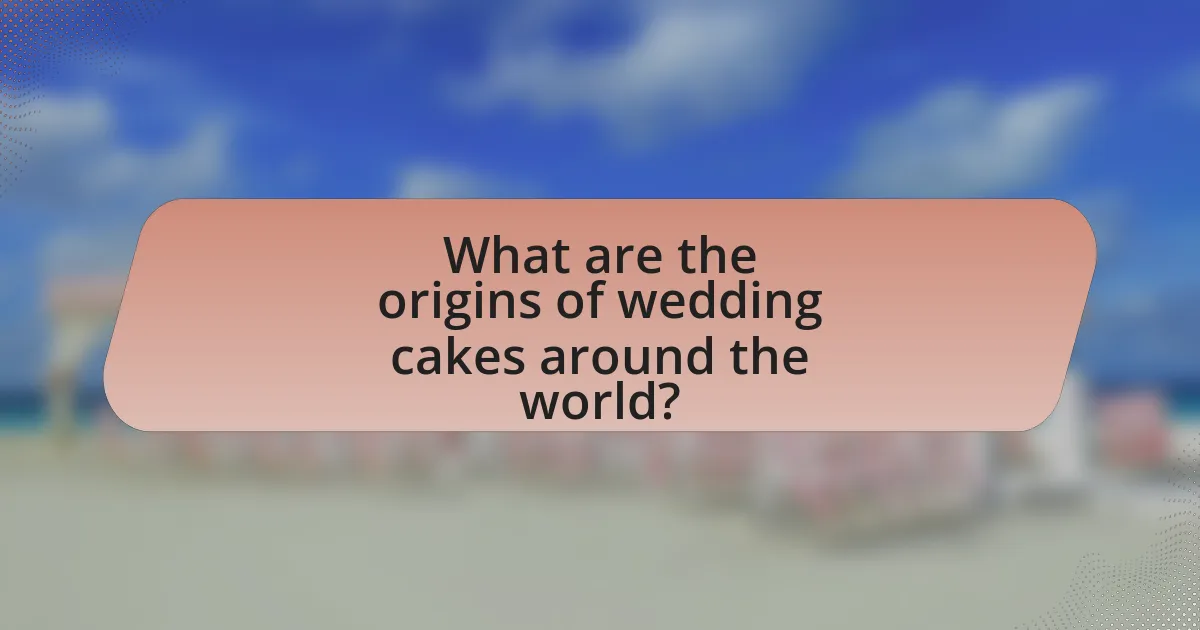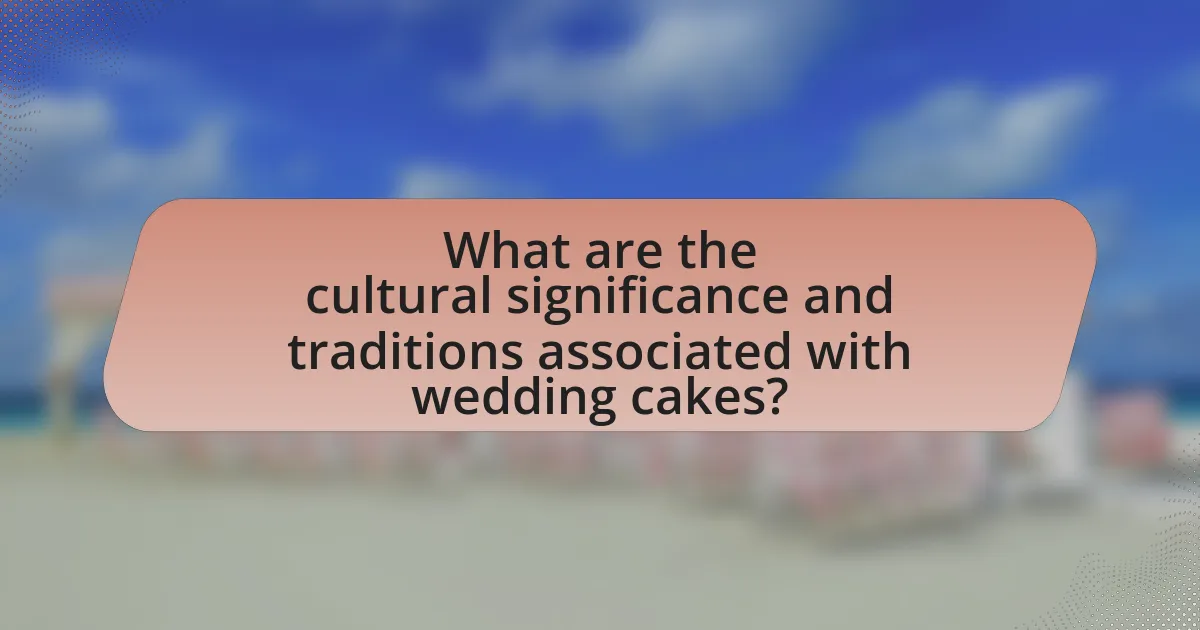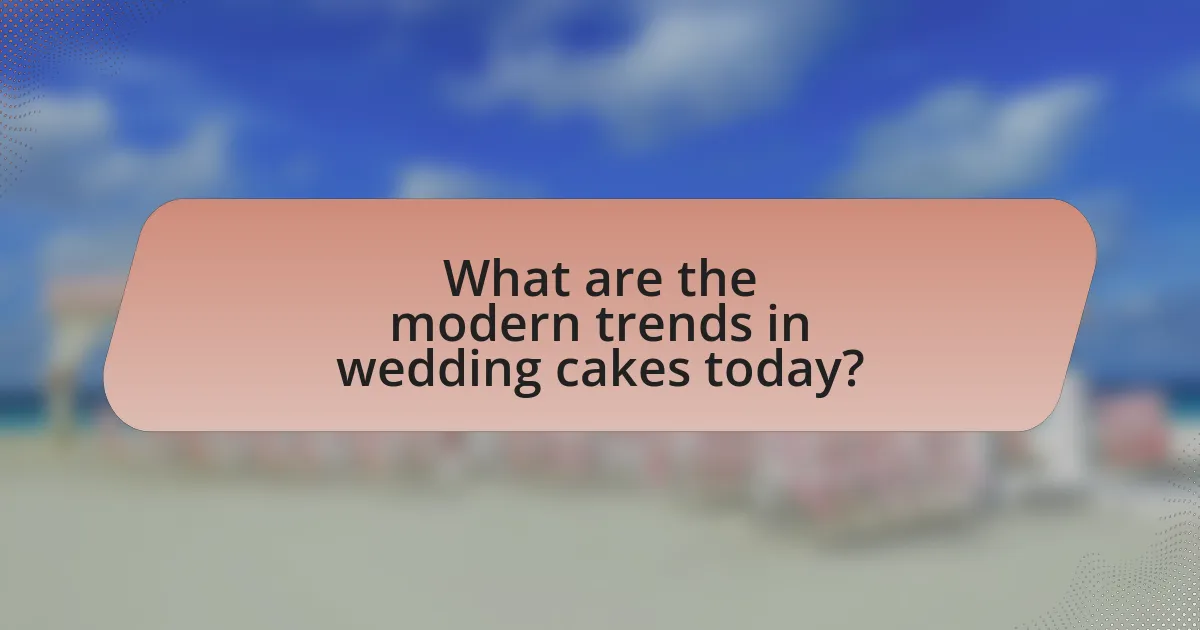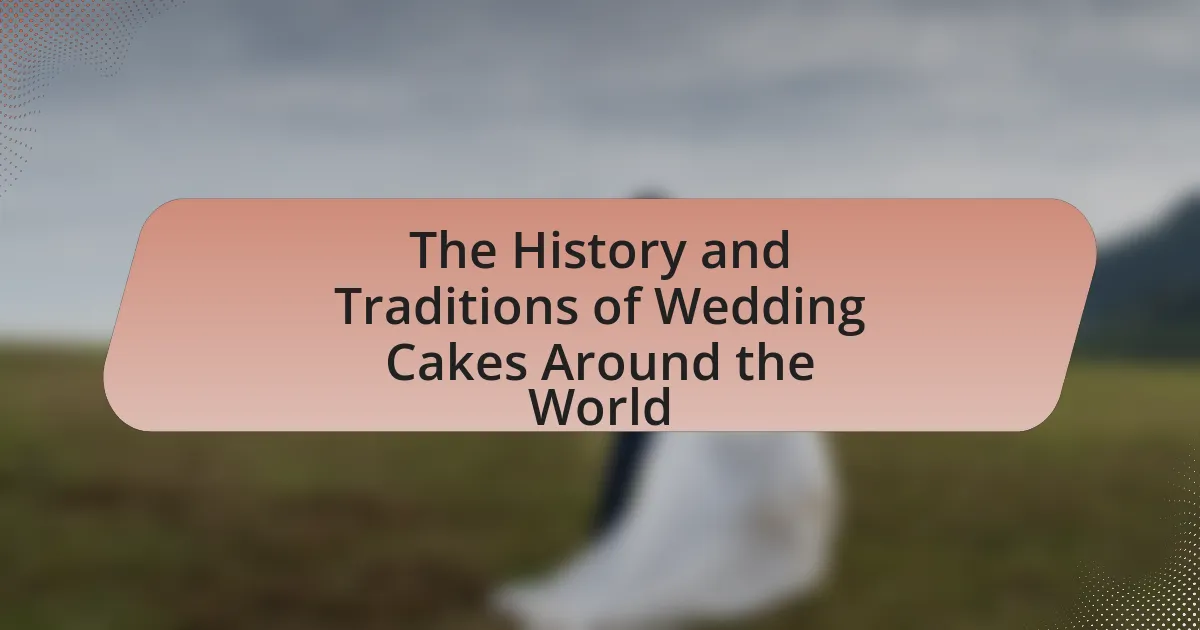The article explores the history and traditions of wedding cakes around the world, tracing their origins from ancient Rome to modern times. It highlights the evolution of wedding cakes, detailing how they transitioned from simple barley cakes to elaborate multi-tiered confections, influenced by various cultures such as the Romans, Greeks, and Egyptians. The article discusses the symbolism associated with wedding cakes, including their representation of prosperity and good fortune, and examines regional variations in ingredients and flavors that reflect local customs. Additionally, it addresses contemporary trends in wedding cake design, personalization, and the challenges couples face when selecting their cakes, providing insights into the cultural significance of this wedding tradition.

What are the origins of wedding cakes around the world?
The origins of wedding cakes around the world can be traced back to ancient Rome, where a simple barley cake was broken over the bride’s head to symbolize fertility and good fortune. In medieval England, wedding cakes evolved into more elaborate fruitcakes, often stacked to represent prosperity. The tradition of a tiered cake emerged in the 19th century, particularly with the introduction of refined sugar, allowing for intricate designs. In various cultures, such as in Japan and India, wedding cakes take on unique forms, often incorporating local ingredients and customs, reflecting the diverse meanings and significance of marriage across different societies.
How did wedding cakes evolve through history?
Wedding cakes evolved from simple bread offerings in ancient Rome to elaborate multi-tiered confections in modern times. Initially, Roman wedding ceremonies featured a cake made of wheat or barley, which symbolized fertility and prosperity. Over time, during the Middle Ages, cakes became sweeter and were often made with honey and spices, reflecting the availability of new ingredients. By the 17th century, the introduction of refined sugar allowed for more intricate designs, leading to the creation of the traditional fruitcake, which was favored for its longevity. The Victorian era saw the rise of the white wedding cake, symbolizing purity, and the use of royal icing for decoration. Today, wedding cakes are often personalized and can be made from various flavors and styles, reflecting individual tastes and cultural traditions.
What ancient cultures influenced the creation of wedding cakes?
Ancient cultures that influenced the creation of wedding cakes include the Romans, Greeks, and Egyptians. The Romans introduced a cake made of wheat or barley, which was broken over the bride’s head as a symbol of fertility. The Greeks created a honey cake called “sposi,” which was offered to the gods during weddings. Egyptians used honey and nuts in their cakes, symbolizing prosperity and fertility. These practices laid the foundation for modern wedding cake traditions, showcasing the significance of cakes in marital celebrations across different cultures.
How did the symbolism of wedding cakes change over time?
The symbolism of wedding cakes has evolved significantly from ancient times to the present. Initially, wedding cakes represented fertility and prosperity, often made of simple ingredients like barley and wheat in ancient Rome, symbolizing abundance. Over time, particularly during the medieval period, the cakes became more elaborate, with the introduction of sugar and the tiered structure, symbolizing the couple’s social status and wealth. By the Victorian era, the white icing on cakes became a symbol of purity and the ideal of a perfect marriage. In contemporary times, wedding cakes now reflect personal tastes and styles, symbolizing individuality and creativity, moving away from traditional meanings to embrace personal narratives and themes. This shift illustrates how cultural values and societal changes influence the symbolism associated with wedding cakes throughout history.
What are the traditional ingredients used in wedding cakes globally?
Traditional ingredients used in wedding cakes globally include flour, sugar, eggs, butter, and various flavorings such as vanilla or almond extract. These basic components form the foundation of most wedding cakes, with variations depending on regional customs. For instance, in the United Kingdom, fruitcake is commonly used, incorporating dried fruits, nuts, and spices, while in Italy, a traditional wedding cake may feature layers of sponge cake filled with ricotta or mascarpone cheese. The use of these ingredients is rooted in historical practices, where cakes were often made to symbolize prosperity and fertility, reflecting the cultural significance of weddings across different societies.
How do regional ingredients reflect local customs and traditions?
Regional ingredients reflect local customs and traditions by embodying the cultural heritage and agricultural practices of a specific area. For instance, in Italy, the use of almonds and citrus in wedding cakes signifies the Mediterranean climate and local farming, while in the UK, the incorporation of dried fruits and spices in traditional fruitcakes reflects historical trade routes and seasonal availability. These ingredients not only enhance the flavor and texture of the cakes but also serve as a representation of the community’s identity, values, and celebrations, linking food to social rituals and historical narratives.
What are the most common flavors found in wedding cakes worldwide?
The most common flavors found in wedding cakes worldwide include vanilla, chocolate, and fruit flavors such as lemon and raspberry. Vanilla is favored for its versatility and classic appeal, while chocolate offers a rich alternative that is popular in many cultures. Fruit flavors, particularly lemon and raspberry, are often chosen for their refreshing taste and ability to complement the sweetness of the cake. These flavors are widely recognized and frequently used in wedding cake recipes across various regions, reflecting both tradition and contemporary preferences.

What are the cultural significance and traditions associated with wedding cakes?
Wedding cakes hold significant cultural importance and are steeped in various traditions across different societies. Traditionally, wedding cakes symbolize prosperity, fertility, and good fortune for the couple, with the act of cutting the cake representing the couple’s first task together as partners. In many cultures, it is customary for the bride and groom to share the first slice, reinforcing their unity.
Historically, in ancient Rome, guests would break bread over the bride’s head to bestow good luck, which evolved into the modern practice of cake cutting. In England, the tiered wedding cake became popular in the 19th century, symbolizing the couple’s social status and wealth. Additionally, in some cultures, such as in Italy, the wedding cake is often a multi-layered fruitcake, reflecting the couple’s commitment to a fruitful life together.
These traditions and meanings associated with wedding cakes illustrate their role as a central element in wedding celebrations, serving not only as a dessert but also as a symbol of love, commitment, and cultural heritage.
How do different cultures celebrate with wedding cakes?
Different cultures celebrate with wedding cakes in unique ways that reflect their traditions and values. For instance, in Western cultures, a multi-tiered white cake symbolizes purity and is often adorned with intricate decorations, while in Italy, the traditional wedding cake, known as “torta nuziale,” is typically a fruitcake soaked in liqueur, representing prosperity and fertility. In India, wedding cakes may not be as common, but when included, they often feature vibrant colors and flavors, symbolizing joy and celebration. Additionally, in Mexico, the “torta de boda” is a rich, layered cake that is often served with a sweet wine, emphasizing community and family ties. These variations illustrate how wedding cakes serve not only as a dessert but also as a cultural symbol, embodying the values and customs of each society.
What unique customs are associated with wedding cakes in various countries?
Unique customs associated with wedding cakes vary significantly across countries. In England, the tradition involves a multi-tiered fruitcake, symbolizing prosperity, with the top tier often saved for the child’s christening. In Italy, the “Torta Nuziale” is typically a rich, layered cake, and it is customary for the couple to cut it together, symbolizing their unity. In Greece, a traditional wedding cake is often topped with a sugar-coated almond, representing fertility and prosperity. In Mexico, the “torta de boda” is often a three-layer cake, and it is common for guests to take a piece home as a token of good luck. These customs reflect cultural values and beliefs surrounding marriage and celebration, illustrating the diverse significance of wedding cakes worldwide.
How do wedding cake traditions vary between religious ceremonies?
Wedding cake traditions vary significantly between religious ceremonies, reflecting the beliefs and customs of each faith. For example, in Christian weddings, a tiered white cake symbolizes purity and is often adorned with figurines representing the couple, while in Jewish weddings, a round cake, often a babka or sponge cake, is served, symbolizing the cycle of life. In Hindu ceremonies, a multi-layered cake may be decorated with vibrant colors and intricate designs, representing prosperity and joy. These variations are rooted in the cultural significance and religious symbolism associated with marriage in each tradition, illustrating how wedding cakes serve not only as a dessert but also as a representation of the couple’s faith and heritage.
Why are wedding cakes considered a symbol of prosperity and good fortune?
Wedding cakes are considered a symbol of prosperity and good fortune because they represent abundance and the couple’s hopes for a fruitful life together. Historically, the act of sharing cake during weddings dates back to ancient Rome, where guests would break bread over the bride’s head to bestow blessings of fertility and prosperity. This tradition evolved, and the multi-tiered wedding cake became a centerpiece, symbolizing the couple’s wealth and social status. The cake’s sweetness is also associated with happiness and good luck, reinforcing its role as a token of well-wishing for the couple’s future.
What historical beliefs contributed to the symbolism of wedding cakes?
Historical beliefs that contributed to the symbolism of wedding cakes include the idea of fertility and prosperity. In ancient Rome, guests would break a cake made of wheat or barley over the bride’s head to bestow good fortune and fertility upon the couple. This practice evolved into the modern wedding cake tradition, where the cake symbolizes abundance and the couple’s shared future. Additionally, in medieval England, the stacking of cakes represented the couple’s unity and the hope for a fruitful marriage, reinforcing the cake’s role as a symbol of celebration and prosperity in marital unions.
How do modern interpretations of wedding cake symbolism differ from traditional views?
Modern interpretations of wedding cake symbolism emphasize personalization and individuality, contrasting with traditional views that primarily focused on fertility and prosperity. Traditionally, wedding cakes symbolized the couple’s union and were often made with specific ingredients believed to bring good fortune, such as fruit and spices. In contemporary settings, couples often choose unique flavors, designs, and themes that reflect their personalities and relationship, moving away from the conventional white cake. This shift highlights a broader cultural trend towards customization in weddings, where the cake serves as a representation of the couple’s story rather than solely a symbol of fertility or abundance.

What are the modern trends in wedding cakes today?
Modern trends in wedding cakes today include a focus on unique flavors, minimalist designs, and personalized elements. Couples increasingly opt for non-traditional flavors such as lavender, matcha, and even savory options, moving away from the classic vanilla and chocolate. Additionally, minimalist designs featuring clean lines, single-tier cakes, and subtle color palettes are gaining popularity, reflecting a modern aesthetic. Personalization is also key, with couples incorporating elements that represent their story, such as custom cake toppers or edible images. These trends are supported by industry reports indicating a shift towards more individualized and creative cake options in recent years.
How have wedding cake designs evolved in contemporary weddings?
Wedding cake designs have evolved significantly in contemporary weddings, shifting from traditional multi-tiered cakes to more personalized and artistic creations. Modern couples often opt for unique flavors, unconventional shapes, and intricate decorations that reflect their individual styles and themes, moving away from the classic white icing and fruitcake. For instance, the rise of fondant and buttercream techniques has allowed for smoother finishes and more elaborate designs, while the incorporation of non-traditional elements like edible flowers, metallic accents, and even alternative materials such as cheese or cupcakes showcases a broader range of creativity. This evolution is supported by trends in wedding planning that emphasize personalization and experiential elements, as evidenced by the increasing popularity of custom cake designs that cater to specific tastes and aesthetics.
What are the most popular styles and themes for wedding cakes currently?
The most popular styles and themes for wedding cakes currently include minimalist designs, floral accents, and geometric patterns. Minimalist cakes often feature clean lines and simple color palettes, reflecting a modern aesthetic that appeals to contemporary couples. Floral accents, whether through fresh flowers or intricate sugar work, add a romantic touch and are frequently used in various wedding themes. Geometric patterns, including hexagons and triangles, are gaining traction for their unique and modern appeal, often combined with bold colors or metallic finishes. These trends are supported by wedding industry reports indicating a shift towards personalization and artistic expression in cake design.
How do couples personalize their wedding cakes to reflect their identities?
Couples personalize their wedding cakes to reflect their identities by incorporating unique flavors, designs, and themes that resonate with their personal stories and cultural backgrounds. For instance, some couples choose flavors that represent their heritage, such as traditional recipes from their families, while others may opt for modern or unconventional flavors that symbolize their relationship. Additionally, cake designs often feature personalized elements like monograms, favorite colors, or motifs that represent shared interests, such as hobbies or travel experiences. This personalization not only enhances the visual appeal of the cake but also serves as a meaningful representation of the couple’s journey together, making the cake a central part of their wedding celebration.
What are the common challenges faced when choosing a wedding cake?
Common challenges faced when choosing a wedding cake include selecting the right flavor, managing dietary restrictions, and balancing budget constraints. Couples often struggle with flavor choices due to the wide variety available, which can lead to disagreements. Additionally, accommodating guests with allergies or dietary preferences, such as gluten-free or vegan options, complicates the decision-making process. Budget limitations further challenge couples, as custom cakes can be expensive, and finding a balance between quality and cost is essential. According to a survey by The Knot, the average cost of a wedding cake in the U.S. is around $350, which can strain budgets if not planned carefully.
How can couples effectively communicate their vision to a baker?
Couples can effectively communicate their vision to a baker by providing clear and detailed descriptions of their desired cake design, flavors, and any specific themes or inspirations. This includes sharing visual references, such as photos of cakes they admire, and discussing color schemes, textures, and any personal elements they wish to incorporate. Research indicates that visual aids significantly enhance understanding in creative collaborations, making it easier for bakers to grasp the couple’s expectations and preferences. By engaging in an open dialogue and asking for the baker’s input, couples can ensure that their vision aligns with the baker’s expertise, resulting in a cake that meets their desires.
What factors should be considered when selecting the size and flavor of a wedding cake?
When selecting the size and flavor of a wedding cake, key factors include the number of guests, the wedding theme, and personal preferences. The size of the cake must accommodate all attendees, typically calculated at one slice per guest, ensuring everyone is served. The flavor should reflect the couple’s tastes and can also align with the wedding theme; for example, a rustic wedding may favor flavors like carrot or spice, while a formal event might lean towards classic options like vanilla or chocolate. Additionally, seasonal ingredients can influence flavor choices, as they often provide fresher and more vibrant tastes.
What tips can couples follow to ensure a successful wedding cake experience?
Couples can ensure a successful wedding cake experience by selecting a reputable baker, clearly communicating their preferences, and scheduling tastings. A reputable baker will have experience and positive reviews, which increases the likelihood of a satisfactory outcome. Clear communication about flavors, design, and dietary restrictions helps the baker create a cake that meets the couple’s expectations. Scheduling tastings allows couples to sample different flavors and make informed decisions, ensuring the cake is both visually appealing and delicious. These practices are supported by industry standards, where customer satisfaction is linked to effective communication and quality assurance in baking.
